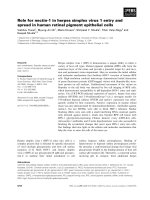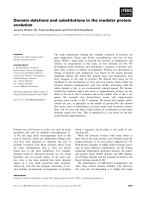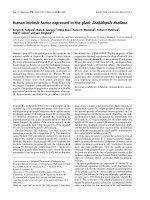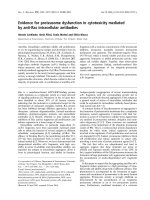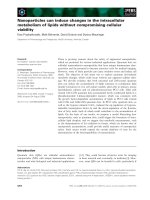Báo cáo khoa học: "Remifentanil for analgesia-based sedation in the intensive care unit" pdf
Bạn đang xem bản rút gọn của tài liệu. Xem và tải ngay bản đầy đủ của tài liệu tại đây (34.48 KB, 3 trang )
13
ICU = intensive care unit.
Available online />Providing effective analgesia and adequate sedation is a
generally accepted goal in the intensive care unit (ICU). Most
critically ill patients – especially those who are mechanically
ventilated – are treated with various analgesics and sedative
drugs, which have primarily been investigated for their short-
term use for anaesthesia during surgical interventions.
Recent studies suggest that longer term administration of
these drugs might be associated with significant risks and
adverse effects. Therefore, we must learn that their use has
to undergo a risk–benefit assessment as strict as is required
for other treatments.
In this issue of Critical Care two investigations further
promote our understanding of analgesics and sedatives in
critically ill patients by investigating the use of remifentanil for
analgesia-based sedation protocols in the ICU setting [1,2].
Breen and colleagues [2] investigated the clinical effects of
continuous remifentanil infusion for up to 72 hours
supplemented by propofol in ICU patients with impaired or
normal renal function. They found that scheduled down-
titrations of the remifentanil infusion at 8, 24, 48 and
72 hours resulted in statistically significant but clinically
irrelevant differences in time to offset of sedative effect, as
assessed on the basis of clinical signs. This observation in an
ICU setting substantiates data suggesting that remifentanil
clearance is clinically independent of renal function because
of its esterase dependent metabolism [3]. The metabolite
remifentanil acid is known to accumulate in renal failure [3],
but because this metabolite is approximately 1/4600 less
potent than remifentanil [4] this should not result in any
clinical effect. This hypothesis was supported by Breen and
colleagues [2], who found no correlation between
remifentanil acid and time to offset of analgesic and sedative
effects in patients with renal dysfunction. No differences in
adverse events related to the study drug were found,
although the number of adverse events was higher in the
renal failure group, probably reflecting their increased
Commentary
Remifentanil for analgesia-based sedation in the intensive care
unit
Ralf Kuhlen
1
and Christian Putensen
2
1
Professor of Anesthesia and Intensive Care Medicine, Department of Anesthesia, University Hospital Aachen, Germany
2
Professor of Anesthesia and Intensive Care Medicine, Department of Anesthesia and Intensive Care Medicine, University of Bonn, Germany
Correspondence: Ralf Kuhlen,
Published online: 17 December 2003 Critical Care 2004, 8:13-14 (DOI 10.1186/cc2421)
This article is online at />© 2004 BioMed Central Ltd (Print ISSN 1364-8535; Online ISSN 1466-609X)
Abstract
Providing effective analgesia and adequate sedation is a generally accepted goal of intensive care
medicine. Due to its rapid, organ independent and predictable metabolism the short acting opioid
remifentanil might be particularly useful for analgesia-based sedation in the intensive care unit (ICU).
This hypothesis was tested by two studies in this issue of Critical Care. The study by Breen et al.
shows that remifentanil does not exert prolonged clinical effects when continuously infused in renal
failure patients, although the weak acting metabolite remifentanil acid accumulates. The study by
Muellejans et al. reports a multicenter trial comparing a remifentanil versus a fentanyl based regimen in
ICU patients. With both substances a target analgesia and sedation level was reached, and no major
differences were found when frequent assessments of the sedation level and according readjustments
of doses were performed. These results are in accordance with other studies suggesting that the
adherence to a clear analgesia-based sedation protocol might be more important then the choice of
medications itself.
Keywords analgesia, sedation, remifentanil, organ failure
14
Critical Care February 2004 Vol 8 No 1 Kuhlen and Putensen
morbidity. Remifentanil was found to be as safe in renal
failure patients as in patients with normal renal function. Half
of the patients did not need any propofol when remifentanil
was used as the primary agent.
This observation in favour of an analgesia-based sedation
regimen using remifentanil is in accordance with the results
of the study by Muellejans and colleagues [1], who
compared remifentanil with fentanyl for analgesia-based
sedation in a double-blind, multicentre, randomized controlled
trial mainly in postoperative ICU patients. Those investigators
reported that both remifentanil and fentanyl were able to
achieve the targeted sedation level of 4 on the
Sedation–Agitation Scale [5] (reflecting a calm and easily
arousable state, in which the patient is able to follow
commands) in almost 90% of the duration of sedation.
However, there was clearly less variability in the remifentanil
group, suggesting a more constant and predictable effect of
remifentanil. Again, the analgesia-based regimen provided
comfort without supplementation with propofol in
approximately 60–65% of the patients in either group, with a
lower total propofol dose needed in the remifentanil treated
group. Rapid recovery from sedation and low transition times
to extubation (about 1 hour) were found for both groups,
without any apparent difference. This is somewhat surprising
because, due to its short-acting nature, remifentanil was
thought to result in faster times to recovery, as has been
shown in trauma and major surgery patients [6]. This
observation further supports the idea that clear differences in
the pharmacokinetics of sedative substances might be less
important when goal-directed use of those agents is
employed [7]. This was the case in the study reported by
Muellejans and colleagues [1], because frequent
assessments and reassessments were scheduled by the
study protocol in order to adhere to the strict goal of
maintining an Sedation–Agitation Scale score of 4. Because
of its rapid metabolism, pain was more frequently
experienced in patients after remifentanil was stopped than in
the fentanyl group. This indicates the need for a strict
analgesia protocol, anticipating the rapid offset of
pharmacological effect when using short-acting remifentanil.
Clear evidence exists that the use of treatment protocols for
sedatives and analgesics is effective in terms of improving
clinical outcomes, mainly by avoiding unnecessary
overdosing, with prolonged mechanical ventilation and stay in
the ICU [7,8]. Brook and coworkers [9] reported a shorter
duration of mechanical ventilation, and shorter stay in the ICU
and hospital, which was associated with fewer
tracheotomies, in acute respiratory failure patients when a
written protocol defining the goal of sedation was followed
by nurses. In that investigation, a Ramsay score of 3 (patient
awake and responds to commands only) [10] was targeted.
Kress and colleagues [11] reported that a daily interruption
of sedation in mechanically ventilated patients may reduce
many of the complications associated with sedatives and
results in improved clinical outcomes. On an average of 86%
of all ICU days, those investigators found that patients who
had been assessed daily were awake and able to follow
commands, as compared with only 9% in the control group.
Most interestingly, this was not accompanied by any
subsequent negative long-term psychological effect in the
patients who had been assessed on a daily basis. Moreover,
long-term follow up suggested that in those patients
post-traumatic stress disorders were less pronounced or
even less frequent [12]. The protocol was equally effective
when applied to a midazolam-based or a propofol-based
sedation regimen, without any significant difference between
substances; however, clear pharmacokinetic differences are
obvious and have been reported to result in clinical
differences when agents are compared with each other
without a goal-orientated protocol [13]. It is probable that
adherence to a strict and goal-orientated algorithm for
defining, assessing and reassessing analgesia and sedation
is more important than finding the magic bullet for a particular
substance [7].
However, adherence to such a protocol might be much
easier in routine clinical work when short-acting substances
with low potential for overdosing are available, as is the case
for remifentanil. The two observations made by Breen and
coworkers [2] and Muellejans and colleagues [1] suggest
that this agent may be used safely in many ICU patients, even
when renal failure develops. The hypothesis that in real-world
ICU conditions remifentanil would allow easier adherence to
an analgesia and sedation protocol, thereby resulting in
improved clinical outcomes, must be addressed in larger
scale studies.
Competing interests
None declared.
References
1. Muellejans B, López A, Cross MH, Bonome C, Morrison L, Kirkham
AJT: Remifentanil versus fentanyl for analgesia based sedation
to provide comfort in the ICU. Crit Care 2003, 8:R1-R11.
2. Breen D, Wilmer A, Bodenham A, Bach V, Bonde J, Kessler P
Albrecht S, Shaikh S: The offset of pharmacodynamic effects
and safety of remifentanil in ICU patients with various
degrees of renal impairment. Crit Care 2003, 8:R21-R30.
3. Hoke JF, Shlugman D, Dershwitz M, Michalowski P, Malthouse-
Dufore S, Connors PM, Martel D, Rosow CE, Muir KT, Rubin N,
Glass PS: Pharmacokinetics and pharmacodynamics of
remifentanil in persons with renal failure compared with
healthy volunteers. Anesthesiology 1997, 87:533-541.
4. Hoke JF, Cunningham F, James MK, Muir KT, Hoffman WE: Com-
parative pharmacokinetics and pharmacodynamics of
remifentanil, its principle metabolite (GR90291) and alfentanil
in dogs. J Pharmacol Exp Ther 1997, 281:226-232.
5. Riker RR, Picard JT, Fraser GL: Prospective evaluation of the
Sedation-Agitation Scale for adult critically ill patients. Crit
Care Med 1999, 27:1325-1329.
6. Soltesz S, Biedler A, Silomon M, Schopflin I, Molter GP: Recov-
ery after remifentanil and sufentanil for analgesia and seda-
tion of mechanically ventilated patients after trauma or major
surgery. Br J Anaesth 2001, 86:763-768.
7. Kress JP, Pohlman AS, Hall JB: Sedation and analgesia in the
intensive care unit. Am J Respir Crit Care Med 2002, 166:1024-
1028.
15
8. Jacobi J, Fraser GL, Coursin DB, Riker RR, Fontaine D, Wittbrodt
ET, Chalfin DB, Masica MF, Bjerke HS, Coplin WM, Crippen DW,
Fuchs BD, Kelleher RM, Marik PE, Nasraway SA Jr, Murray MJ,
Peruzzi WT, Lumb PD; Task Force of the American College of
Critical Care Medicine (ACCM) of the Society of Critical Care
Medicine (SCCM), American Society of Health-System Pharma-
cists (ASHP), American College of Chest Physicians: Clinical
practice guidelines for the sustained use of sedatives and
analgesics in the critically ill adult. Crit Care Med 2002, 30:
119-141.
9. Brook AD, Ahrens TS, Schaiff R, Prentice D, Sherman G,
Shannon W, Kollef MH: Effect of a nursing-implemented seda-
tion protocol on the duration of mechanical ventilation. Crit
Care Med 1999, 27:2609-2615.
10. Ramsay MA, Savege TM, Simpson BR, Goodwin R: Controlled
sedation with alphaxalone-alphadolone. BMJ 1974, 2:656-
659.
11. Kress JP, Pohlman AS, O’Connor MF, Hall JB: Daily interruption
of sedative infusions in critically ill patients undergoing
mechanical ventilation. N Engl J Med 2000, 342:1471-1477.
12. Kress JP, Gehlbach B, Lacy M, Pliskin N, Pohlman AS, Hall JB:
The long term psychological effects of daily sedative interrup-
tion in critically ill patients. Am J Respir Crit Care Med
2003:epub ahead of print.
13. Kress JP, O’Connor MF, Pohlman AS, Olson D, Lavoie A,
Toledano A, Hall JB: Sedation of critically ill patients during
mechanical ventilation. A comparison of propofol and midazo-
lam. Am J Respir Crit Care Med 1996, 153:1012-1018.
Available online />

